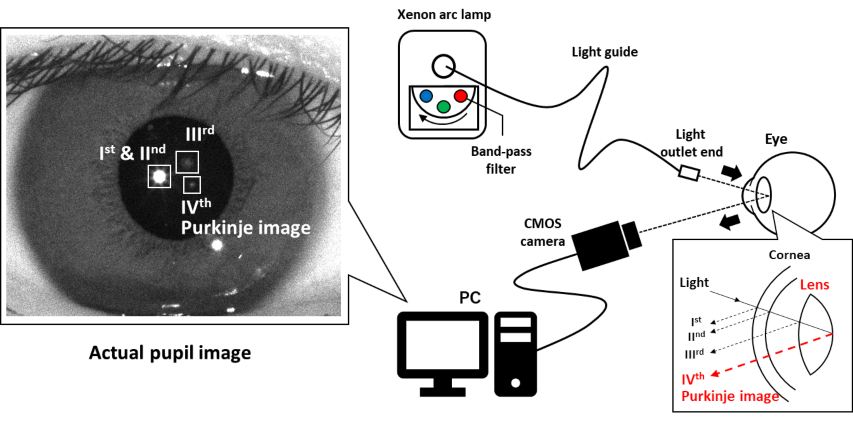研究成果 Research Results
- TOP
- News
- Research Results
- Safe, easy, and rapid measurement of eye lens opacity and transmission
Safe, easy, and rapid measurement of eye lens opacity and transmission
Newly developed system can analyze key properties of the lens without disturbing the eye 2020.11.26Research ResultsArt & DesignLife & Health

A schematic diagram of the system and an image of Purkinje images captured by it. Light from a xenon arc lamp is passed through a band-pass filter and is incident on the eye. The light reflected from the posterior surface of the crystalline lens is detected by a CMOS camera.
Objective measurement of the opacity and transmittance of the lens in the human eye may one day become a simple and rapid process routinely performed at eye clinics thanks in part to a new system developed by an international team led by researchers at Kyushu University.
As we age, the crystalline lenses in our eyes gradually become opaque, leading to a decrease in the light transmitted into the eye.
Information on how opaque the lens is and how much light passes through it at different wavelengths—a property known as the spectral transmittance—can be useful for cataract diagnosis and various research fields.
However, no simple methods currently exist to simultaneously measure lens opacity—also referred to as optical density— and spectral transmittance without first extracting the lens from the eye.
Researchers led by Shigekazu Higuchi, professor of the Faculty of Design, and graduate student Taisuke Eto at Kyushu University now report that they have developed a new system that can measure both properties safely, easily, and rapidly without disturbing the eye.
Developed in collaboration with researchers at the Singapore Eye Research Institute, the system can take measurements in about four seconds using only a light source, an imaging device, and computer for analysis.
The system works by analyzing images formed by the reflection of different wavelengths of light at the interface between the lens and the gel-like vitreous humor inside the eye.
Based on these so-called IVth Purkinje images, the system measures lens opacity as a function of wavelength, which it then uses to estimate the spectral transmittance.
The method produces the same results even without dilating the pupils, further contributing to its ease of use.
The researchers have filed a patent for the system and are aiming to develop a portable and compact version in the future.
“By providing a wealth of information on both lens opacities and spectral characteristics, such a device has the potential to contribute to new discoveries in the field of lens-related research,” says Eto.
###
For more information about this research, see “A Purkinje image‑based system for an assessment of the density and transmittance spectra of the human crystalline lens in vivo,” Taisuke Eto, Petteri Teikari, Raymond P. Najjar, Yuki Nishimura, Yuki Motomura, Manami Kuze, and Shigekazu Higuchi, Scientific Reports (2020). https://doi.org/10.1038/s41598-020-73541-y
This work was supported by JSPS KAKENHI Grant Number JP17K18926.
Research-related inquiries
Shigekazu Higuchi, Professor
Department of Human Science, Faculty of Design
Contact information can also be found in the full release.
- TOP
- News
- Research Results
- Safe, easy, and rapid measurement of eye lens opacity and transmission































